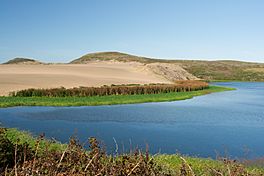Abbotts Lagoon facts for kids
Quick facts for kids Abbotts Lagoon |
|
|---|---|
 |
|
| Location | Marin County, California |
| Coordinates | 38°7′3″N 122°57′12″W / 38.11750°N 122.95333°W |
| Type | lagoon |
| Primary outflows | Pacific Ocean |
| Basin countries | United States |
| Surface elevation | sea level |
Abbotts Lagoon is a unique water area found on the northwestern coast of the Point Reyes National Seashore in California, United States. It's made up of two parts. The upper part is fresh water. This water then flows into a lower part, which is a mix of fresh and salt water. Sometimes in winter, ocean tides can reach this lower section. The eastern side of the lagoon has old northern coastal scrub plants. These include coyote bush, yellow bush lupine, sword fern, and California blackberry.
Contents
How Abbotts Lagoon Was Formed
Abbotts Lagoon is usually separated from the Pacific Ocean by sandy dunes on its western side. The land on the eastern side of the lagoon has older sedimentary rock. These rocks formed from layers of sand and mud over millions of years. They are found on the western side of the San Andreas Fault. A ridge of rock, called Santa Margarita Sandstone, runs along the southern part of the valley. This ridge can be seen along the eastern shore of the lower lagoon.
A Look at Abbotts Lagoon's Past
Long ago, the Coast Miwok people lived around Abbotts Lagoon. In the 1800s, European settlers arrived and started using the land for cattle and dairy farms.
Lagoon's Role in World War II
From 1941 to 1952, Abbotts Lagoon had a surprising role. It was used as a practice area for dive bomber pilots. These pilots came from Naval Air Station Alameda and Naval Auxiliary Landing Field Santa Rosa. They called it "Bombing Range Number Two." After this period, in 1962, the lagoon became part of the Point Reyes National Seashore. This protected it for nature and public enjoyment.
Fun Things to Do at Abbotts Lagoon
Abbotts Lagoon is a great place to explore nature. There are walking trails where you can see many different birds and wildflowers. The area has special habitats that are unique to this spot.
Animals You Might See
You might spot several animals around the lagoon. Look for brush rabbits, black-tailed jackrabbits, pocket gophers, muskrats, river otters, and black-tailed deer. Sometimes, if you are very lucky, you might even see a coyote, bobcat, gray fox, long-tailed weasel, striped skunk, raccoon, badger, or a cougar.
Birdwatching at the Lagoon
Abbotts Lagoon is a fantastic spot for birdwatching. Many different kinds of birds visit or live here. You can see various ducks like mallards and cinnamon teal. There are also different types of gulls and hawks flying overhead.
Birds of Abbotts Lagoon
Some of the many bird species observed here include:
- Ducks: American wigeon, bufflehead, mallard, northern pintail, ruddy duck
- Geese: black brant
- Grebes: pied-billed grebe, western grebe
- Gulls: California gull, western gull
- Hawks: osprey, red-tailed hawk, white-tailed kite
- Herons: great blue heron, great egret, snowy egret
- Hummingbirds: Allen's hummingbird, Anna's hummingbird
- Loons: common loon, Pacific loon
- Owls: burrowing owl, short-eared owl
- Pelicans: brown pelican
- Plovers: killdeer, western snowy plover (The western snowy plover is a "threatened" species, meaning it needs protection.)
- Quail: California quail
- Raven: Common raven
- Sandpipers: marbled godwit, sanderling
- Sparrows: song sparrow, white-crowned sparrow
- Swallows: barn swallow, tree swallow
- Swans: trumpeter swan, tundra swan
- Vulture: Turkey vulture
Plants of Abbotts Lagoon
Abbotts Lagoon is also home to a very special and rare plant. It is the only place in the world where the Sonoma spineflower (Chorizanthe valida) still grows naturally. This plant is endangered, which means it is at risk of disappearing forever. Protecting its home at Abbotts Lagoon is very important.




